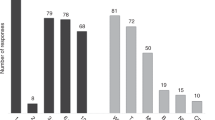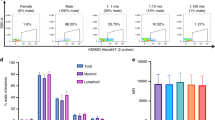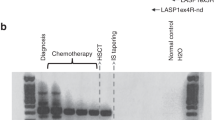Abstract
Sequential analysis of chimerism after allogeneic blood stem cell transplantation (BSCT) has been shown to be predictive for graft failure and relapse. We have explored the impact of a novel approach for the quantitative determination of chimerism using a commercial PCR assay with multiplex amplification of nine STR-loci and fluorescence detection. The feasibility was studied in 121 patients transplanted from related or unrelated donors. Follow-up investigation was performed in 88 patients. Twenty-eight of these patients had received a transplantation after dose-reduced conditioning therapy. Results were compared to data obtained by FISH analysis in a subgroup of patients receiving grafts from sex-mismatched donors. The analysis was possible in all patients, the median number of informative alleles was 4 (range 1–8) compared to 7 (range 1–9) in the related and unrelated situation, respectively. A good correlation was seen in 84 samples from 14 patients analyzed in parallel with STR-PCR and FISH. Decreasing values of donor chimerism were detected prior to or concomitantly with the occurrence of graft failure and relapse of disease in all patients investigated prospectively. Using FACS-sorted material, eg peripheral blood CD34+ cells, the assay permitted the detection of residual recipient cells with high sensitivity (down to one CD34+ Kasumi cell in 40 000 normal WBC). Evaluation of the inter-laboratory reproducibility revealed that in 20 samples analyzed in three different centers, the median coefficient of variation was 2.1% (range 0.7–9.6%). Taken together, the results support the use of the test as a valuable tool in the follow-up of patients undergoing allogeneic BSCT. In cases lacking PCR-detectable disease-specific gene products, this assay may represent an alternative to recently established real-time PCR methods.
This is a preview of subscription content, access via your institution
Access options
Subscribe to this journal
Receive 12 print issues and online access
$259.00 per year
only $21.58 per issue
Buy this article
- Purchase on Springer Link
- Instant access to full article PDF
Prices may be subject to local taxes which are calculated during checkout








Similar content being viewed by others
References
Henslee DP, Abhyankar SH, Parrish RS, Pati AR, Godder KT, Neglia WJ, Goon JK, Geier SS, Lee CG, Gee AP . Use of partially mismatched related donors extends access to allogeneic marrow transplant Blood 1997 89: 3864–3872
Aversa F, Tabilio A, Velardi A, Cunningham I, Terenzi A, Falzetti F, Ruggeri L, Barbabietola G, Aristei C, Latini P, Reisner Y, Martelli MF . Treatment of high-risk acute leukemia with T-cell-depleted stem cells from related donors with one fully mismatched HLA haplotype N Engl J Med 1998 339: 1186–1193
Giralt S, Estey E, Albitar M, van Besien K, Rondon G, Anderlini P, O'Brien S, Khouri I, Gajewski J, Mehra R, Claxton D, Andersson B, Beran M, Przepiorka D, Koller C, Kornblau S, Korbling M, Keating M, Kantarjian H, Champlin R . Engraftment of allogeneic hematopoietic progenitor cells with purine analog-containing chemotherapy: harnessing graft-versus-leukemia without myeloablative therapy Blood 1997 89: 4531–4536
Marmont AM, Horowitz MM, Gale RP, Sobocinski K, Ash RC, van-Bekkum DW, Champlin RE, Dicke KA, Goldman JM, Good RA et al. T-cell depletion of HLA-identical transplants in leukemia Blood 1991 78: 2120–2130
Gardiner N, Lawler M, O'Riordan JM, Duggan C, De-Arce M, McCann SR . Monitoring of lineage-specific chimaerism allows early prediction of response following donor lymphocyte infusions for relapsed chronic myeloid leukaemia Bone Marrow Transplant 1998 21: 711–719
Bader P, Beck J, Schlegel PG, Handgretinger R, Niethammer D, Klingebiel T . Additional immunotherapy on the basis of increasing mixed hematopoietic chimerism after allogeneic BMT in children with acute leukemia: is there an option to prevent relapse? Bone Marrow Transplant 1997 20: 79–81
Rapanotti MC, Arcese W, Buffolino S, Iori AP, Mengarelli A, De-Cuia MR, Cardillo A, Cimino G . Sequential molecular monitoring of chimerism in chronic myeloid leukemia patients receiving donor lymphocyte transfusion for relapse after bone marrow transplantation Bone Marrow Transplant 1997 19: 703–707
Dubovsky J, Daxberger H, Fritsch G, Printz D, Peters C, Matthes S, Gadner H, Lion T, Muller-Berat N . Kinetics of chimerism during the early post-transplant period in pediatric patients with malignant and non-malignant hematologic disorders: implications for timely detection of engraftment, graft failure and rejection Leukemia 1999 13: 2060–2069
Bader P, Klingebiel T, Schaudt A, Theurer-Mainka U, Handgretinger R, Lang P, Niethammer D, Beck JF . Prevention of relapse in pediatric patients with acute leukemias and MDS after allogeneic SCT by early immunotherapy initiated on the basis of increasing mixed chimerism: a single center experience of 12 children Leukemia 1999 13: 2079–2086
Wessman M, Ruutu T, Volin L, Knuutila S . In situ hybridization using a Y-specific probe – a sensitive method for distinguishing residual male recipient cells from female donor cells in bone marrow transplantion Bone Marrow Transplant 1989 4: 283–286
Oberkircher AR, Strout MP, Herzig GP, Fritz PD, Caligiuri MA . Description of an efficient and highly informative method for the evaluation of hematopoietic chimerism following allogeneic bone marrow transplantation Bone Marrow Transplant 1995 16: 695–702
Palka G, Stuppia L, Di-Bartolomeo P, Morizio E, Peila R, Franchi PG, Calabrese G . FISH detection of mixed chimerism in 33 patients submitted to bone marrow transplantation Bone Marrow Transplant 1996 17: 231–236
Najfeld V, Burnett W, Vlachos A, Scigliano E, Isola L, Fruchtman S . Interphase FISH analysis of sex-mismatched BMT utilizing dual color XY probes Bone Marrow Transplant 1997 19: 829–834
Lapointe C, Forest L, Lussier P, Busque L, Lagace F, Perreault C, Roy DC, Gyger M . Sequential analysis of early hematopoietic reconstitution following allogeneic bone marrow transplantation with fluorescence in situ hybridization (FISH) Bone Marrow Transplant 1996 17: 1143–1148
Dewald G, Stallard R, Al Saadi A, Arnold S, Bader PI, Blough R, Chen K, Elejalde BR, Harris CJ, Higgins RR, Hoeltge GA, Hsu WT, Kubic V, McCorquodale DJ, Micale MA, Moore JW, Phillips RM, Scheib-Wixted S, Schwartz S, Siembieda S, Strole K, VanTuinen P, Vance GH, Wiktor A, Zinsmeister A . A multicenter investigation with interphase fluorescence in situ hybridization using X- and Y-chromosome probes Am J Med Genet 1998 76: 318–326
Lawler M, Humphries P, McCann SR . Evaluation of mixed chimerism by in vitro amplification of dinucleotide repeat sequences using the polymerase chain reaction Blood 1991 77: 2504–2514
Ugozzoli L, Yam P, Petz LD, Ferrara GB, Champlin RE, Forman SJ, Koyal D, Wallace RB . Amplification by the polymerase chain reaction of hypervariable regions of the human genome for evaluation of chimerism after bone marrow transplantation Blood 1991 77: 1607–1615
Martinelli G, Trabetti E, Zaccaria A, Farabegoli P, Buzzi M, Testoni N, Calori E, Bandini G, Rosti G, Belardinelli A et al. In vitro amplification of hypervariable DNA regions for the evaluation of chimerism after allogeneic BMT Bone Marrow Transplant 1993 12: 115–120
Muniz ES, Plassa F, Amselem S, Goossens M, Vernant JP . Molecular analysis of polymorphic loci to study chimerism after allogeneic bone marrow transplantation. Heteroduplex analysis in denaturing gradient gel electrophoresis: a new approach to detecting residual host cells Transplantation 1994 57: 451–456
Suttorp M, Schmitz N, Dreger P, Schaub J, Loffler H . Monitoring of chimerism after allogeneic bone marrow transplantation with unmanipulated marrow by use of DNA polymorphisms Leukemia 1993 7: 679–687
Socie G, Lawler M, Gluckman E, McCann SR, Brison O . Studies on hemopoietic chimerism following allogeneic bone marrow transplantation in the molecular biology era Leukemia Res 1995 19: 497–504
Scharf SJ, Smith AG, Hansen JA, McFarland C, Erlich HA . Quantitative determination of bone marrow transplant engraftment using fluorescent polymerase chain reaction primers for human identity markers Blood 1995 85: 1954–1963
Stuppia L, Calabrese G, Di-Bartolomeo P, Peila R, Franchi PG, Morizio E, Palka G . Retrospective investigation of hematopoietic chimerism after BMT by PCR amplification of hypervariable DNA regions Cancer Genet Cytogenet 1995 85: 124–128
Bader P, Holle W, Klingebiel T, Handgretinger R, Niethammer D, Beck J . Quantitative assessment of mixed hematopoietic chimerism by polymerase chain reaction after allogeneic BMT Anticancer Res 1996 16: 1759–1763
Briones J, Urbano IA, Rozman C, Marin P, Carreras E, Rovira M, Sierra J, Colomer D, Martinez C, Montserrat E . Study of hematopoietic chimerism following allogeneic peripheral blood stem cell transplantation using PCR amplification of short tandem repeats Ann Hematol 1996 72: 265–268
Rothberg PG, Gamis AS, Baker D . Use of DNA polymorphisms to monitor engraftment after allogeneic bone marrow transplantation Clin Lab Med 1997 17: 109–118
Thiede C, Florek M, Bornhäuser M, Ritter M, Mohr B, Brendel C, Ehninger G, Neubauer A . Rapid quantification of mixed chimerism using multiplex amplification of short tandem repeat markers and fluorescence detection Bone Marrow Transplant 1999 23: 1055–1060
Thiede C, Prange-Krex G, Freiberg-Richter J, Bornhauser M, Ehninger G . Buccal swabs but not mouthwash samples can be used to obtain pretransplant DNA fingerprints from recipients of allogeneic bone marrow transplants Bone Marrow Transplant 2000 25: 575–577
Bornhäuser M, Mohr B, Ehrenlechner U, Neubauer A, Ehninger G . Fluorescence in situ hybridization for the BCR/ABL rearrangement is dependent on the percentage of nonlymphocytic cells in peripheral blood stem cell harvests J Hematother 1998 7: 425–430
Ritter M, Thiede C, Schakel U, Schmidt M, Alpen B, Pascheberg U, Mohr B, Ehninger G, Neubauer A . Underestimation of inversion(16) in acute myeloid leukaemia using standard cytogenetics as compared with polymerase chain reaction: results of a prospective investigation Br J Haematol 1997 98: 969–972
Khouri IF, Keating M, Korbling M, Przepiorka D, Anderlini P, O'Brien S, Giralt S, Ippoliti C, von-Wolff B, Gajewski J, Donato M, Claxton D, Ueno N, Andersson B, Gee A, Champlin R . Transplant-lite: induction of graft-versus-malignancy using fludarabine-based nonablative chemotherapy and allogeneic blood progenitor-cell transplantation as treatment for lymphoid malignancies J Clin Oncol 1998 16: 2817–2824
Childs R, Bahceci E, Clave E, van Rhee F, Jayasekera D, Mayo G . Non-myeloablative allogeneic peripheral blood stem cell transplants (PBSCT) for malignant diseases reduces transplant-related mortality (TRM) Blood 1998 92: A552. (Abstr.)
Bader P, Holle W, Klingebiel T, Handgretinger R, Benda N, Schlegel PG, Niethammer D, Beck J . Mixed hematopoietic chimerism after allogeneic bone marrow transplantation: the impact of quantitative PCR analysis for prediction of relapse and graft rejection in children Bone Marrow Transplant 1997 19: 697–702
Gardiner N, Lawler M, O'Riordan J, De'Arce M, McCann SR . Donor chimaerism is a strong indicator of disease free survival following bone marrow transplantation for chronic myeloid leukaemia Leukemia 1997 11: (Suppl. 3) 512–515
Roman J, Martin C, Torres A, Garcia A, Andres P, Garcia MJ, Baiget M . Importance of mixed chimerism to predict relapse in persistently BCR/ABL positive long survivors after allogeneic bone marrow transplantation for chronic myeloid leukemia Leuk Lymphoma 1998 28: 541–550
van Leeuwen JE, van Tol MJ, Joosten AM, Wijnen JT, Verweij PJ, Khan PM, Vossen JM . Persistence of host-type hematopoiesis after allogeneic bone marrow transplantation for leukemia is significantly related to the recipient's age and/or the conditioning regimen, but it is not associated with an increased risk of relapse Blood 1994 83: 3059–3067
Bornhäuser M, Neubauer A, Thiede C, Naumann R, Ritter M, Geissler G, Mohr B, Schuler U, Ehninger G . Allogeneic blood stem cell transplantants from unrelated donors after nonablative conditioning therapy Blood 1998 92: 355b (Abstr.)
Mangioni S, Balduzzi A, Rivolta A, Rovelli A, Nesi F, Rossi V, Busca A, Uderzo C, Miniero R, Biondi A . Long-term persistence of hemopoietic chimerism following sex-mismatched bone marrow transplantation Bone Marrow Transplant 1997 20: 969–973
Gardiner N, Lawler M, O'Riordan J, DeArce M, Humphries P, McCann SR . Persistent donor chimaerism is consistent with disease-free survival following BMT for chronic myeloid leukaemia Bone Marrow Transplant 1997 20: 235–241
Lion T, Henn T, Gaiger A, Kalhs P, Gadner H . Early detection of relapse after bone marrow transplantation in patients with chronic myelogenous leukaemia Lancet 1993 341: 275–276
Cross NC, Feng L, Chase A, Bungey J, Hughes TP, Goldman JM . Competitive polymerase chain reaction to estimate the number of BCR-ABL transcripts in chronic myeloid leukemia patients after bone marrow transplantation Blood 1993 82: 1929–1936
Drobyski WR, Endean DJ, Klein JP, Hessner MJ . Detection of BCR/ABL RNA transcripts using the polymerase chain reaction is highly predictive for relapse in patients transplanted with unrelated marrow grafts for chronic myelogenous leukaemia Br J Haematol 1997 98: 458–466
Lin F, van-Rhee F, Goldman JM, Cross NC . Kinetics of increasing BCR-ABL transcript numbers in chronic myeloid leukemia patients who relapse after bone marrow transplantation Blood 1996 87: 4473–4478
Radich JP, Gehly G, Gooley T, Bryant E, Clift RA, Collins S, Edmands S, Kirk J, Lee A, Kessler P, Schoch G, Buckner CD, Sullivan KM, Appelbaum FR, Thomas ED . Polymerase chain reaction detection of the BCR-ABL fusion transcript after allogeneic marrow transplantation for chronic myeloid leukemia: results and implications in 346 patients Blood 1995 85: 2632–2638
Kogler G, Wolf HH, Heyll A, Arkesteijn G, Wernet P . Detection of mixed chimerism and leukemic relapse after allogeneic bone marrow transplantation in subpopulations of leucocytes by fluorescent in situ hybridization in combination with the simultaneous immunophenotypic analysis of interphase cells Bone Marrow Transplant 1995 15: 41–48
Lamb LSJ, Robbins NF, Abhyankar S, Joyce M, Stetler SM, Henslee DP, Gee AP . Flow cytometric cell sorting combined with molecular chimerism analysis to detect minimal recurrent leukemia: good news and bad news Bone Marrow Transplant 1997 19: 1157–1161
Gyger M, Baron C, Forest L, Lussier P, Lagace F, Bissonnette I, Belanger R, Bonny Y, Busque L, Roy DC, Perreault C . Quantitative assessment of hematopoietic chimerism after allogeneic bone marrow transplantation has predictive value for the occurrence of irreversible graft failure and graft-versus-host disease Exp Hematol 1998 26: 426–434
Briones J, Urbano IA, Orfao A, Marin P, Sierra J, Rovira M, Carreras E, Rozman C, Montserrat E . Demonstration of donor origin of CD34+ HLA-DR− bone marrow cells after allogeneic peripheral blood transplantation with a long follow-up Bone Marrow Transplant 1998 21: 189–194
Keil F, Haas OA, Fritsch G, Kalhs P, Lechner K, Mannhalter C, Reiter E, Niederwieser D, Hoecker P, Greinix HT . Donor leukocyte infusion for leukemic relapse after allogeneic marrow transplantation: lack of residual donor hematopoiesis predicts aplasia Blood 1997 89: 3113–3117
Bader P, Beck J, Frey A, Schlegel PG, Hebarth H, Handgretinger R, Einsele H, Niemeyer C, Benda N, Faul C, Kanz L, Niethammer D, Klingebiel T . Serial and quantitative analysis of mixed hematopoietic chimerism by PCR in patients with acute leukemias allows the prediction of relapse after allogeneic BMT Bone Marrow Transplant 1998 21: 487–495
Lion T, Muller-Berat N . Chimerism testing after allogeneic stem cell transplantation: importance of timing and optimal technique for chimerism testing in different clinical-biological situations Leukemia 1999 13: 2059
Mensink E, van-de-Locht A, Schattenberg A, Linders E, Schaap N, Geurts-van KA, De-Witte T . Quantitation of minimal residual disease in Philadelphia chromosome positive chronic myeloid leukaemia patients using real-time quantitative RT-PCR Br J Haematol 1998 102: 768–774
Acknowledgements
The authors would like to thank Mrs Ulrike Löwel, Marita Hartwig and Heidrun Klose for excellent technical assistance. Furthermore, the help of the clinical and laboratory staff of the Dr Mildred-Scheel bone marrow transplantation center at the university clinic in Dresden is highly acknowledged. This study was supported in part by grants from the Deutsche Krebshilfe (Project No. 70–2210-Eh5), the German José Carreras foundation (AN) and funding from the Technical University Dresden Research Program (CT/MB).
Author information
Authors and Affiliations
Rights and permissions
About this article
Cite this article
Thiede, C., Bornhäuser, M., Oelschlägel, U. et al. Sequential monitoring of chimerism and detection of minimal residual disease after allogeneic blood stem cell transplantation (BSCT) using multiplex PCR amplification of short tandem repeat-markers. Leukemia 15, 293–302 (2001). https://doi.org/10.1038/sj.leu.2401953
Received:
Accepted:
Published:
Issue Date:
DOI: https://doi.org/10.1038/sj.leu.2401953
Keywords
This article is cited by
-
Factors predicting survival following alloSCT in patients with therapy-related AML and MDS: a multicenter study
Bone Marrow Transplantation (2023)
-
Chimerism analysis for clinicians: a review of the literature and worldwide practices
Bone Marrow Transplantation (2022)
-
Lineage-specific early complete donor chimerism and risk of relapse after allogeneic hematopoietic stem cell transplantation for acute myeloid leukemia
Bone Marrow Transplantation (2022)
-
Monitoring minimal residual/relapsing disease after allogeneic haematopoietic stem cell transplantation in adult patients with acute lymphoblastic leukaemia
Bone Marrow Transplantation (2020)
-
Multiplex STR panel for assessment of chimerism following hematopoietic stem cell transplantation (HSCT)
Annals of Hematology (2019)



